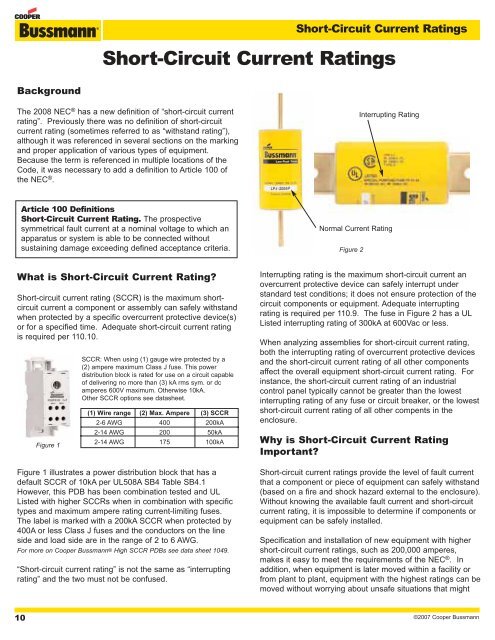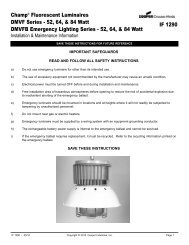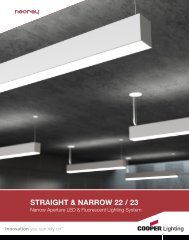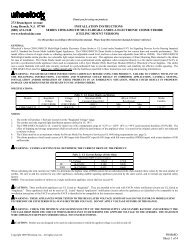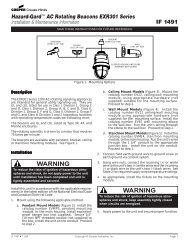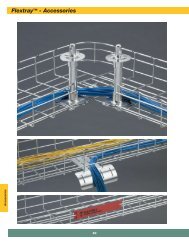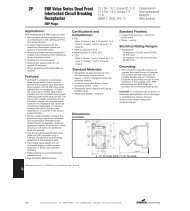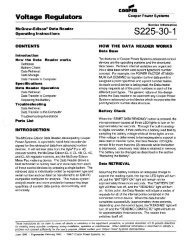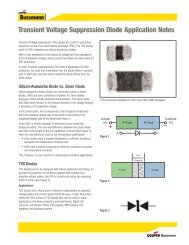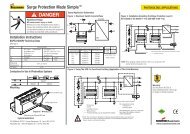Short-Circuit Current Ratings - Cooper Industries
Short-Circuit Current Ratings - Cooper Industries
Short-Circuit Current Ratings - Cooper Industries
Create successful ePaper yourself
Turn your PDF publications into a flip-book with our unique Google optimized e-Paper software.
Background<br />
10<br />
<strong>Short</strong>-<strong>Circuit</strong> <strong>Current</strong> <strong>Ratings</strong><br />
<strong>Short</strong>-<strong>Circuit</strong> <strong>Current</strong> <strong>Ratings</strong><br />
The 2008 NEC ® has a new definition of “short-circuit current<br />
rating”. Previously there was no definition of short-circuit<br />
current rating (sometimes referred to as “withstand rating”),<br />
although it was referenced in several sections on the marking<br />
and proper application of various types of equipment.<br />
Because the term is referenced in multiple locations of the<br />
Code, it was necessary to add a definition to Article 100 of<br />
the NEC ® .<br />
Article 100 Definitions<br />
<strong>Short</strong>-<strong>Circuit</strong> <strong>Current</strong> Rating. The prospective<br />
symmetrical fault current at a nominal voltage to which an<br />
apparatus or system is able to be connected without<br />
sustaining damage exceeding defined acceptance criteria.<br />
What is <strong>Short</strong>-<strong>Circuit</strong> <strong>Current</strong> Rating?<br />
<strong>Short</strong>-circuit current rating (SCCR) is the maximum shortcircuit<br />
current a component or assembly can safely withstand<br />
when protected by a specific overcurrent protective device(s)<br />
or for a specified time. Adequate short-circuit current rating<br />
is required per 110.10.<br />
Figure 1<br />
SCCR: When using (1) gauge wire protected by a<br />
(2) ampere maximum Class J fuse. This power<br />
distribution block is rated for use on a circuit capable<br />
of delivering no more than (3) kA rms sym. or dc<br />
amperes 600V maximum. Otherwise 10kA.<br />
Other SCCR options see datasheet.<br />
(1) Wire range (2) Max. Ampere (3) SCCR<br />
2-6 AWG 400 200kA<br />
2-14 AWG 200 50kA<br />
2-14 AWG 175 100kA<br />
Figure 1 illustrates a power distribution block that has a<br />
default SCCR of 10kA per UL508A SB4 Table SB4.1<br />
However, this PDB has been combination tested and UL<br />
Listed with higher SCCRs when in combination with specific<br />
types and maximum ampere rating current-limiting fuses.<br />
The label is marked with a 200kA SCCR when protected by<br />
400A or less Class J fuses and the conductors on the line<br />
side and load side are in the range of 2 to 6 AWG.<br />
For more on <strong>Cooper</strong> Bussmann® High SCCR PDBs see data sheet 1049.<br />
“<strong>Short</strong>-circuit current rating” is not the same as “interrupting<br />
rating” and the two must not be confused.<br />
Figure 2<br />
Interrupting Rating<br />
Normal <strong>Current</strong> Rating<br />
Interrupting rating is the maximum short-circuit current an<br />
overcurrent protective device can safely interrupt under<br />
standard test conditions; it does not ensure protection of the<br />
circuit components or equipment. Adequate interrupting<br />
rating is required per 110.9. The fuse in Figure 2 has a UL<br />
Listed interrupting rating of 300kA at 600Vac or less.<br />
When analyzing assemblies for short-circuit current rating,<br />
both the interrupting rating of overcurrent protective devices<br />
and the short-circuit current rating of all other components<br />
affect the overall equipment short-circuit current rating. For<br />
instance, the short-circuit current rating of an industrial<br />
control panel typically cannot be greater than the lowest<br />
interrupting rating of any fuse or circuit breaker, or the lowest<br />
short-circuit current rating of all other compents in the<br />
enclosure.<br />
Why is <strong>Short</strong>-<strong>Circuit</strong> <strong>Current</strong> Rating<br />
Important?<br />
<strong>Short</strong>-circuit current ratings provide the level of fault current<br />
that a component or piece of equipment can safely withstand<br />
(based on a fire and shock hazard external to the enclosure).<br />
Without knowing the available fault current and short-circuit<br />
current rating, it is impossible to determine if components or<br />
equipment can be safely installed.<br />
Specification and installation of new equipment with higher<br />
short-circuit current ratings, such as 200,000 amperes,<br />
makes it easy to meet the requirements of the NEC ® . In<br />
addition, when equipment is later moved within a facility or<br />
from plant to plant, equipment with the highest ratings can be<br />
moved without worrying about unsafe situations that might<br />
©2007 <strong>Cooper</strong> Bussmann
<strong>Short</strong>-<strong>Circuit</strong> <strong>Current</strong> Rating Requirements<br />
arise from placing the equipment in a new location where the<br />
available short-circuit current is higher than the old location<br />
and now above the rating of the equipment.<br />
How to Determine <strong>Short</strong>-<strong>Circuit</strong> <strong>Current</strong><br />
Rating?<br />
For components, the short-circuit current rating is typically<br />
determined by product testing. For assemblies, the marking<br />
can be determined through the equipment product listing<br />
standard or by an approved method. With the release of the<br />
UL508A, UL Standard for Safety for Industrial Control<br />
Panels, an industry-approved method is now available. UL<br />
508A, Supplement SB, provides an analytical method to<br />
determine the short-circuit current rating of an industrial<br />
control panel. This method is based upon the weakest link<br />
approach. In other words, the assembly marked short-circuit<br />
current rating is limited to the lowest rated component shortcircuit<br />
current rating or the lowest rated overcurrent<br />
protective device interrupting rating.<br />
How to Increase <strong>Short</strong>-<strong>Circuit</strong> <strong>Current</strong><br />
Rating?<br />
Protection with current-limiting fuses is the easiest, lowest<br />
cost and most effective way to achieve higher short-circuit<br />
current ratings. For components, a motor controller can be<br />
used to illustrate this point very well. The <strong>Cooper</strong> Bussmann ®<br />
compact, non-fused disconnect, the CDNF63, is a Listed UL<br />
508 Manual Motor Controller with a maximum horsepower<br />
rating of 40hp at 480V. It is marked with a short-circuit<br />
current rating of 5kA when protected by a 150A (or less)<br />
Class H fuse or circuit breaker. However, the short-circuit<br />
current rating for the CDNF63 is marked 100kA when<br />
protected by a 100A (or less) Class J or T fuse (<strong>Cooper</strong><br />
Bussmann LPJ-110SP or JJS-100).<br />
When using UL 508A Supplement SB, there are significant<br />
advantages to using current-limiting fuses in industrial control<br />
panels.<br />
1. The high interrupting rating (typically 200kA) of currentlimiting<br />
fuses increases the ability to achieve higher shortcircuit<br />
current ratings. If using typical circuit breakers,<br />
interrupting ratings are often only 10,000 or 14,000<br />
amperes, which limits the short-circuit current rating of the<br />
individual control panel to 10,000 or 14,000 amperes.<br />
2. The use of current-limiting fuses in industrial control panels<br />
can also increase component short-circuit current ratings<br />
through combination ratings (higher fault current ratings of<br />
components when a specific overcurrent protection device<br />
is provided). <strong>Current</strong>ly, the only method to achieve high<br />
short-circuit current ratings with terminal and power<br />
distribution blocks is through the use of current-limiting<br />
fuses.<br />
©2007 <strong>Cooper</strong> Bussmann<br />
3. If current limiting fuses are used in the feeder circuit of an<br />
industrial control panel, the let-through values in UL508A<br />
Supplement SB can be used to raise downstream branch<br />
circuit component short-circuit current ratings.<br />
What are the <strong>Short</strong>-<strong>Circuit</strong> <strong>Current</strong><br />
Rating Marking Requirements?<br />
The NEC ® has requirements for certain components and<br />
equipment to be marked with their short-circuit current rating.<br />
The important sections of the Code that require the marking<br />
of the short-circuit current rating include:<br />
Industrial Control Panels<br />
409.110 requires that an industrial control panel be marked<br />
with its short-circuit current rating; see Figure 3.<br />
Figure 3<br />
Industrial Machinery Electrical Panel<br />
670.3(A) requires the nameplate on industrial machinery to<br />
include the short-circuit current rating of the machine<br />
industrial control panel. In previous editions of the NEC ®<br />
(2002 Edition) and NFPA 79 (2002 Edition), the industrial<br />
machine nameplate was required to include only the<br />
interrupting rating of the machine overcurrent protective<br />
device, if furnished. This marking was misleading as it did<br />
not represent the short-circuit current rating of the machine<br />
industrial control panel, but could be misinterpreted as such.<br />
11
Air Conditioning and Refrigeration<br />
Equipment with Multimotor and<br />
Combination-Loads<br />
440.4(B) requires the nameplate of this equipment to be<br />
marked with its short-circuit current rating. There are three<br />
exceptions for which this requirement does not apply: one<br />
and two family dwellings, cord and attachment-plug<br />
connected equipment, or equipment on a 60A or less branch<br />
circuit. So for most commercial and industrial applications,<br />
air conditioning and refrigeration equipment with multimotor<br />
and combination loads must have the short-circuit current<br />
rating marked on the nameplate.<br />
Meter Disconnect Switches (rated up to 600V)<br />
230.82(3) permits a meter disconnect switch ahead of the<br />
service disconnecting means, provided the meter disconnect<br />
switch has a short-circuit current rating adequate for the available<br />
short-circuit current.<br />
Motor Controllers<br />
430.8 requires that motor controllers be marked with their<br />
short-circuit current rating. There are three exceptions for<br />
fractional horsepower motor controllers, 2 horsepower or less<br />
general-purpose motor controllers, and where the shortcircuit<br />
current rating is marked on the assembly.<br />
How to Assure Compliance?<br />
To assure proper application, the designer, installer, and<br />
inspector must assure that the marked short-circuit current<br />
rating of a component or equipment is not exceeded by the<br />
calculated available fault current.<br />
In order to assure compliance it is necessary to:<br />
• Determine the available short-circuit current or fault<br />
current at the point of installation of the component or<br />
equipment.<br />
• Assure the component or equipment marked short-circuit<br />
current rating is equal to or greater than the available fault<br />
current. (See Figure 4 for example).<br />
12<br />
Manufacturer Name: Brand XYZ Co.<br />
Voltage - 480V, 3-Phase, 60 Hz<br />
FLA - 140 Amperes<br />
SCCR - 200,000A*<br />
Minimum Cir Amperes: 175<br />
Maximum Fuse: 200<br />
*Suitable for use on a circuit capable<br />
of delivering not less than 200,000<br />
amperes of short-circuit current<br />
Manufacturer Name: Brand XYZ Co.<br />
Voltage - 480V, 3-Phase, 60 Hz<br />
FLA - 140 Amperes<br />
SCCR - 200,000A*<br />
Minimum Cir Amperes: 175<br />
Maximum Fuse: 200<br />
*Suitable for use on a circuit capable<br />
of delivering not less than 200,000<br />
amperes of short-circuit current<br />
Industrial Control Panel<br />
Figure 4 - (Courtesy IAEI)<br />
<strong>Short</strong>-<strong>Circuit</strong> <strong>Current</strong> Rating Requirements<br />
Any installation where the component or equipment marked<br />
short-circuit current rating is less than the available fault<br />
current is a lack of compliance and violation of 110.10. In<br />
these cases, the equipment cannot be installed until the<br />
component or equipment short-circuit current rating is<br />
sufficient or the fault current is reduced by an acceptable<br />
method.<br />
What Resources are Available?<br />
<strong>Cooper</strong> Bussmann offers tools to assist with the proper<br />
application of short-circuit current ratings including:<br />
Simplified Guide to SCCR – Basic Understanding of<br />
short-circuit current ratings and tools to determine the<br />
“weakest-link” for industrial control panels.<br />
Advanced Guide to SCCR – In depth discussion of<br />
short-circuit current ratings, UL 508A Supplement SB, and<br />
how to fix weak-links of industrial control panels.<br />
High SCCR Products<br />
• <strong>Current</strong>-limiting fuses – high interrupting rating does not<br />
limit assembly SCCR and can increase other component<br />
ratings within industrial control panels.<br />
• High SCCR Power Distribution and Terminal Blocks –<br />
high SCCR is available for feeder circuits (with UL 508A<br />
required feeder circuit spacings) and branch circuits.<br />
Open and enclosed (IP-20) power distribution blocks.<br />
• Fuse holders, fused disconnects and non-fused<br />
disconnects with high SCCR<br />
OSCAR (On-Line <strong>Short</strong>-circuit <strong>Current</strong> per UL508A Rating<br />
Calculator Software) – On-line calculator used to determine<br />
and document the short-circuit current rating of industrial<br />
control panels.<br />
SPD (Selecting Protective Devices) – Details how to<br />
understand, determine and comply with short-circuit current<br />
ratings and other overcurrent protection issues.<br />
<strong>Short</strong>-<strong>Circuit</strong> Calculator Program – free software<br />
download to calculate the available fault current at different<br />
points within the electrical distribution system.<br />
For more information on the above see:<br />
http://www.bussmann.com/2/IndustrialMachineryandControl.html<br />
©2007 <strong>Cooper</strong> Bussmann
<strong>Short</strong>-<strong>Circuit</strong> <strong>Current</strong> <strong>Ratings</strong><br />
Note: There are other companion ratings that must be<br />
verified for compliance when installing or inspecting<br />
assemblies. These include:<br />
1.Voltage Rating: be sure the voltage rating for an<br />
assembly is equal to or greater than the system voltage.<br />
When devices such as slash rated circuit breakers or<br />
motor controllers (ie 480/277) are used, the entire<br />
assembly is also limited. Per 240.85 and 430.83(E), a<br />
device, which is slash voltage rated, limits the application<br />
of that device to only solidly grounded wye systems where<br />
the voltage of any conductor to ground does not exceed<br />
the lower value and the voltage between any two<br />
conductors does not exceed the higher value. Similarly,<br />
an entire assembly would have the same limitation, if one<br />
or more devices in the assembly were slash voltage rated<br />
devices. For instance, if equipment is marked 480/277V<br />
due to the use of slash rated motor controllers, it can only<br />
be applied on 480/277V (or less) solidly grounded<br />
systems. It cannot be applied on 480V ungrounded,<br />
impedance grounded, or corner grounded systems. More<br />
information can be found on Voltage Rating on the<br />
<strong>Cooper</strong> Bussmann ® website at<br />
www.cooperbussmann.com/2/ProtectiveDevice<strong>Ratings</strong>.html.<br />
Article 240 VII. <strong>Circuit</strong> Breakers<br />
240.85 Applications.<br />
A circuit breaker with a slash voltage rating, such as<br />
120/240V or 480Y/277V, shall be permitted to be applied<br />
in a solidly grounded circuit where the nominal voltage of<br />
any conductor to ground does not exceed the lower of the<br />
two values of the circuit breaker’s voltage rating and the<br />
nominal voltage between any two conductors does not<br />
exceed the higher value of the circuit breaker’s voltage<br />
rating.<br />
Article 430 VII. Motor Controllers<br />
430.83 <strong>Ratings</strong><br />
(E) Voltage Rating.<br />
A controller with slash rating, for example, 120/240 volts<br />
or 480Y/277 volts, shall only be applied in a solidly<br />
grounded circuit in which the nominal voltage to ground<br />
from any conductor does not exceed the lower of the two<br />
values of the controller’s voltage rating and the nominal<br />
voltage between any two conductors does not exceed the<br />
higher value of the controller’s voltage rating.<br />
2. Single Pole Interrupting Capability: Where higher fault<br />
currents are present, the single pole interrupting capability<br />
of circuit breakers and self-protected combination<br />
controllers can be of concern as indicated in the fine print<br />
notes of 240.85 and 430.52(C)(6). This is because the<br />
single pole interrupting capability is not always equal to the<br />
©2007 <strong>Cooper</strong> Bussmann<br />
three-pole rating. For instance, a 480V, 100A circuit<br />
breaker may have a three pole interrupting rating of<br />
65,000A, but its single pole interrupting capability, based<br />
on UL 489 testing requirements, is only 8,660A. This<br />
single-pole interrupting capability becomes very critical for<br />
ungrounded, corner-grounded, and impedance grounded<br />
systems where full voltage can be seen by only one pole<br />
of the device. More information can be found on<br />
Single-Pole Interrupting Capability on the <strong>Cooper</strong><br />
Bussmann ® website at<br />
www.cooperbussmann.com/2/ProtectiveDevice<strong>Ratings</strong>.html.<br />
240.85 (added in 2002 NEC ® )<br />
FPN: Proper application of molded case circuit breakers<br />
on 3-phase systems, other than solidly grounded wye,<br />
particularly on corner, grounded delta systems, considers<br />
the circuit breakers’ individual pole-interrupting capability.<br />
430.52(C)(6) (added in 2005 NEC ® )<br />
FPN: Proper application of self-protected combination<br />
controllers on 3-phase systems, other than solidly<br />
grounded wye, particularly on corner grounded delta<br />
systems, considers the self-protected combination<br />
controllers’ individual pole-interrupting capability.<br />
Other Considerations<br />
Applying components or equipment within their short-circuit<br />
current rating does not mean the components can not<br />
sustain damage. UL Standards have evaluation criteria for<br />
acceptance to SCCR testing. Components and assemblies<br />
are tested in an enclosure with the bolted short-circuits<br />
external to the enclosure and door closed or cover fastened.<br />
The typical evaluation acceptance criteria by UL is<br />
• The enclosure cannot become energized (shock<br />
hazard)<br />
• The door or cover cannot blow open and there<br />
cannot be any large holes in the enclosure (fire<br />
hazard external to the enclosure). However,<br />
extensive damage may be permitted to the internal<br />
components.<br />
Applying components or equipment within their short-circuit<br />
current rating, does not mean the equipment does not pose<br />
an arc flash hazard. Equipment certification tests are not run<br />
with arcing faults inside the enclosure. An arcing fault<br />
within a closed enclosure is a potentially serious hazard<br />
with the doors closed or open; incidents have been<br />
reported of doors being blown open, or off, due to arcing<br />
faults. A marked short-circuit current rating for an assembly<br />
does not signify that someone working on or near energized<br />
equipment will be uninjured if an arcing fault occurs with the<br />
doors either open or closed and latched.<br />
13


